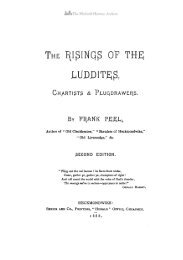OLD MIRFIELD DAYS - Mirfield - A Second Look
OLD MIRFIELD DAYS - Mirfield - A Second Look
OLD MIRFIELD DAYS - Mirfield - A Second Look
You also want an ePaper? Increase the reach of your titles
YUMPU automatically turns print PDFs into web optimized ePapers that Google loves.
pretty place, no railway yet and in front of the Corn Mill a small grass croft it was called the Croft. This<br />
corn mill was a very much used and important place, Hopton Old Bridge, that is Ledgard Bridge, was<br />
built chiefly so that farmers, etc. could get over the river to have their corn ground and to provide a<br />
crossing for people who had left the stagecoach at the Blacksmiths at the top of Kirkheaton Moor, they<br />
then had to walk down Hopton Lane to the North Gate, turn right along a much worn field path and<br />
over the Iron Stee, down the nursery and Chadwick Lane, to come out at the Hopton end of the bridge.<br />
They could now cross the river and go up New Gate and into Eastthorpe Lane, the river would be much<br />
lower than it is now, after the canal was cut and the weir built, it would be higher by a few feet and<br />
provided the power for the corn mill built 1674, incidentally they were the owners of the water rights at<br />
this mill for a long time, the proprietors at this time was John Pilling. Across the road and off New<br />
Gate a kiln was built to deal with barley for malting that could now come by canal.<br />
To the right of this kiln and standing in a lovely garden was a big stone house and farm buildings, it<br />
was a lovely house, but it fell on evil times and finished up as part of a foundry after being a boarding<br />
house. Behind the kiln and nearer to Station Road a boat building business was started and flourished<br />
for a long time, it provided boats for all <strong>Mirfield</strong> boating families, Schofields, Websters, Cloughs,<br />
Walkers, Ledgards, Barkers, Whitfields, Normantons, Wilsons, Burns, and Duttons, there are probably<br />
more I forget. The first railway station was built I believe in 1847, and was at the bottom of New Gate,<br />
just before you cross the river. I have read an article on its opening, it was a grand affair and special<br />
reference to the mill is made and the view presented when passing in the new fangled railway truck, so<br />
we have some idea of the importance attached to a corn mill at this time. Flour would be largely homeproduced<br />
and all animal feed that required preparation would be the product of the local mill, although<br />
at this time very little in the form of bought meal was used on the farm. Turnips had just become<br />
popular and along with the home grown corn provided most of the farms requirements.<br />
THE BLACK BULL HOTEL<br />
13




